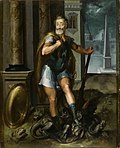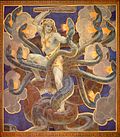Lernaean Hydra
In Greek mythology, the Lernaean Hydra was a serpent-like monster. According to Theogony 313, the Hydra is the child of Typhon and Echidna. The Hydra had many heads.
Gustave Moreau's 19th-century depiction of the Hydra, influenced by the Beast from the Book of Revelation | |
| Other name(s) | Lernaean Hydra |
|---|---|
| Country | Greece |
It is also said that the Hydra's teeth were able to raise skeletons from the dead. There are pictures of the Hydra on vases and bronze plates dating back as far as the 7th century BC.[1]
Hercules (who is called "Heracles" in Greek mythology) kills the Hydra as one of his labors. The Hydra lived in the lake of Lerna in the Argolis. The lake itself is older even than the Mycenaean city of Argos. Lerna was also the site of the myth of the Danaids.
The second of the 12 labors of Hercules was to kill the Hydra. The monster also had one immortal head that was in the middle. All of the heads could spit deadly acid. To defeat the Hydra, Hercules called on his nephew Iolaus for help. As soon as Hercules cut off one head, Iolaus would cauterise the wound with a flaming torch so that nothing could grow to replace it. After removing the Hydra's immortal head, Hercules buried it under a large rock. Then he collected the monster's poisonous blood. In later adventures, he dipped his arrows in the blood to kill other monsters.
Lernaean Hydra Media
Portrait of Henri IV as Hercules pinning the Hydra of Lerna, an allegory of the Navarrese king's defeat of the Catholic League during the French Wars of Religion. Workshop of Toussaint Dubreuil, c. 1600.
Caeretan black-figure hydria (c. 346 BC)
Mosaic from Roman Spain (AD 26)
John Singer Sargent (1921)
Reverse of a 1914 medal by Fritz Eue commemorating General Erich Ludendorff
References
- ↑ Ogden, Daniel 2013. Drakon: dragon myth and serpent cult in the Greek and Roman worlds. Oxford University Press.
- General references
- Graves, Robert (1960), The Greek Myths, Penguin Books, pp. 469–72
- "Hydra." Myths and Legends of the World. 2001. Encyclopedia.com. 11 Apr. 2016<http://www.encyclopedia.com>.








